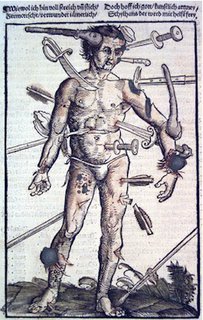 Cutlery metallurgy is a big interest of mine, though I still know very little about it. I have however, learned some important things to look for when considering a kitchen knife.
Cutlery metallurgy is a big interest of mine, though I still know very little about it. I have however, learned some important things to look for when considering a kitchen knife.All knives are different and have different metallurgies. A sword for example, requires a softer steel so it won't shatter on impact. Since this is not an issue with a kitchen knife, hardness is the bottom line. If you happened to catch my earlier post regarding the henckels ceramax line, you'll know that steel hardness is measured using the rockwell scale. The unit is a degree.
Unfortunately, steel is a relatively soft metal. To harden it, knife makers add carbon to make 'carbon-steel.' However carbon-steel knives require more maintainence and are highly susceptible to tarnish and rust. For these reasons carbon-steel knives have lost popularity in the kitchen and have become difficult to find, even though they are sharper than any other knife. The most popular knives today are high-carbon steel knives or HCS. These knives are made by adding elements like, chromium, vanadium, nickel, cobalt and others to decrease the corrosive properties. This negatively effects the sharpness of the knife so manufacturers are constantly trying to find new ways around this tradeoff with different metallurgies and processes.
Any serious knife maker will drop forge their knives. Forging changes the atomic structures and creates a harder, longer lasting knife. Chef's knives, vegetable knives, bread knives and paring knives should always be forged. Boning knives, some slicers and other thin bladed knives benefit from being stamped, because they are always thinner than their forged counterparts.
Ceramic blades are very sharp but often cannot be resharpened and break and chip very easily.
Blade hardness usually means a sharper edge and longer edge retention. However, it's not the only thing that matters. Because most popular knife makers use very high quality steel (which you definitely pay for) as well as state of the art processes, most knives are 56-58 degrees rockwell. What I mean is most blades are comparable as far as strength and hardness and personal taste comes into play. Professional chef's don't all use the same brand of knives. The best knife is one you'll use often for many different tasks that fits comfortably in your hand. The new Henckels line boasts the highest rockwell of any other kitchen knife, however the handle is shaped and weighted in a way I find uncomfortable, making is useless to me.
Blade length is also important, chef knives, slicers and bread knives are completely useless when too short, the way a paring knife is when too long. A chef's knife is also useless when too long. I find using myself poking into other things and running off the board when using my 10" chef knife at home.
Don't get seduced by fancily shapen blades. There are four basic knives essential in every kitchen. They are:
 a good Chef/Cook's Knife - 8-10 inches. This is your all purpose knife used for for anything from boning chicken to cutting vegetables. This is the most valuable knife in your collection and should be the nicest. A well made knife will easily last a lifetime properly taken care of. 8" is usually ideal for the home cook. Any shorter is worthless). Most professionals find anything longer than 10" to be cumbersome for home use. My problem with the chef's knife is the 10 ones are too heavy for lighter work like mincing herbs, cutting fruit etc. But the 8 inch is too short. One of the guys I work with has gotten around this problem with the global 8 1/4" carving knife. Because it's made for slicing, the blade is thinner and light. Global has a habit of making their blades wider than other brands, so it makes sense that the carving knife be just right for light chef knife work. One drawback is that it's not forged, and will probably not keep and edge as long.
a good Chef/Cook's Knife - 8-10 inches. This is your all purpose knife used for for anything from boning chicken to cutting vegetables. This is the most valuable knife in your collection and should be the nicest. A well made knife will easily last a lifetime properly taken care of. 8" is usually ideal for the home cook. Any shorter is worthless). Most professionals find anything longer than 10" to be cumbersome for home use. My problem with the chef's knife is the 10 ones are too heavy for lighter work like mincing herbs, cutting fruit etc. But the 8 inch is too short. One of the guys I work with has gotten around this problem with the global 8 1/4" carving knife. Because it's made for slicing, the blade is thinner and light. Global has a habit of making their blades wider than other brands, so it makes sense that the carving knife be just right for light chef knife work. One drawback is that it's not forged, and will probably not keep and edge as long. 
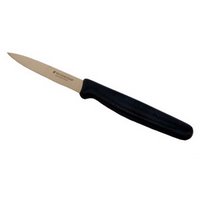 Straight Paring Knife - 3-4 inches. There are many different styles, but this is the most useful.
Straight Paring Knife - 3-4 inches. There are many different styles, but this is the most useful. Serrated Bread Knife - 8-10 inches. I personally prefer the round as opposed to pointed tip because it cuts through though crust better.
Serrated Bread Knife - 8-10 inches. I personally prefer the round as opposed to pointed tip because it cuts through though crust better.Secondary knives include:
 Slicer - 8-12 inches. Length is important because many items being sliced greatly benefit from a single motion and can be damaged by sawing.
Slicer - 8-12 inches. Length is important because many items being sliced greatly benefit from a single motion and can be damaged by sawing.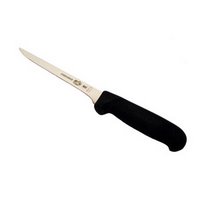 Boning Knife - should have a thin blade, preferably stamped
Boning Knife - should have a thin blade, preferably stamped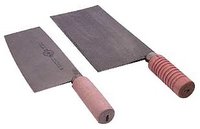 Chinese Cleaver - chinese chefs use these as you would a western style chef's knife. Heavy blade works great for cutting through bone and smashing garlic and ginger.
Chinese Cleaver - chinese chefs use these as you would a western style chef's knife. Heavy blade works great for cutting through bone and smashing garlic and ginger. Meat Slicer with a granton edge. Thin blade and "scallops" cut down surface friction.
Meat Slicer with a granton edge. Thin blade and "scallops" cut down surface friction.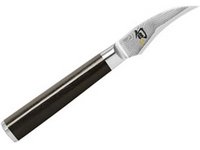 Bird's Beak Peeler/Paring Knife - extremely useful for peeling and small or decorative cuts.
Bird's Beak Peeler/Paring Knife - extremely useful for peeling and small or decorative cuts.Many different asian styles have become popular in recent years. They take the place of western style blade and can easily be swapped out for their western counterparts. These knives are very beautiful and include:
 Chinese Vegetable Cleaver - Usually single beveled, which means the edge is ground on only one side producing a very sharp edge. Often used in place of a chef's knife, though bad for cutting through bone.
Chinese Vegetable Cleaver - Usually single beveled, which means the edge is ground on only one side producing a very sharp edge. Often used in place of a chef's knife, though bad for cutting through bone.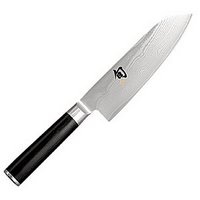 Santoku Knife - 6-7 inches. Thin bladed Japanese vegetable knife. Often used in western cooking as a chef's knife, though not designed for cutting meat or bone.
Santoku Knife - 6-7 inches. Thin bladed Japanese vegetable knife. Often used in western cooking as a chef's knife, though not designed for cutting meat or bone. Deba knife - a heavy duty, all purpose knife. Single beveled. Japanese chef knife great for cutting off fish heads. Properly used in place of a western style chef's knife. similar to a santoku
Deba knife - a heavy duty, all purpose knife. Single beveled. Japanese chef knife great for cutting off fish heads. Properly used in place of a western style chef's knife. similar to a santoku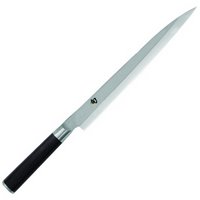 Sashimi Slicer - 10-12 inches. Takes the place of a regular slicer. Designed for more delicate items: fish, sushi, etc.
Sashimi Slicer - 10-12 inches. Takes the place of a regular slicer. Designed for more delicate items: fish, sushi, etc.Since I'm a big geek and japanese knives are extremely beautiful, I plan to put together a set of professional set of them. this would include:
Yanagiba or Takohiki 300mm
Nakkiri 180mm
Kurouchi Mioroshi Deba or Usuba 180mm
Kurouchi Santoku 180mm
Mukimono 105mm
Makiri 75mm
Shun knives are really good, but they're almost more a work of art than a tool. Also, the ebony handles fade when washed with regular dish soaps.
Stay away from specialty knives like, tomato knives and salmon slicers, they take up space and are mostly useless. Any good serrated knife will cut a tomato as well as a tomato knife.
Brands I've found to be popular among professionals include but are certainly not limited to knives from either Solingen, Germany or Seki City, Japan (the knife capitols of the world.) Among these, Wusthof, Global and Messermeister are extremely popular and all rate 56-58 HRC.
One final note. No knife blade is as hard as glass or ceramic, which is why cutting on these surfaces destroys the edge. You should never under any circumstance cut on these surfaces, especially when using a high quality knife. A tight grained wood cutting board is the best surface. Properly maintained wood is more hygegnic than poly or plastic boards because knives cut grooves in plastic that cannot be cleaned. Knives need to be honed often to re-align the edge. Use a fine-ceramic or diamond embedded steel to hone your knife. Regular steels can actually strip metal from the blade and wear down the edge. They are also not hard enough to properly hone a knife. And if you use these knives in the dishwasher, take one out and KILL YOURSELF with it.
No comments:
Post a Comment